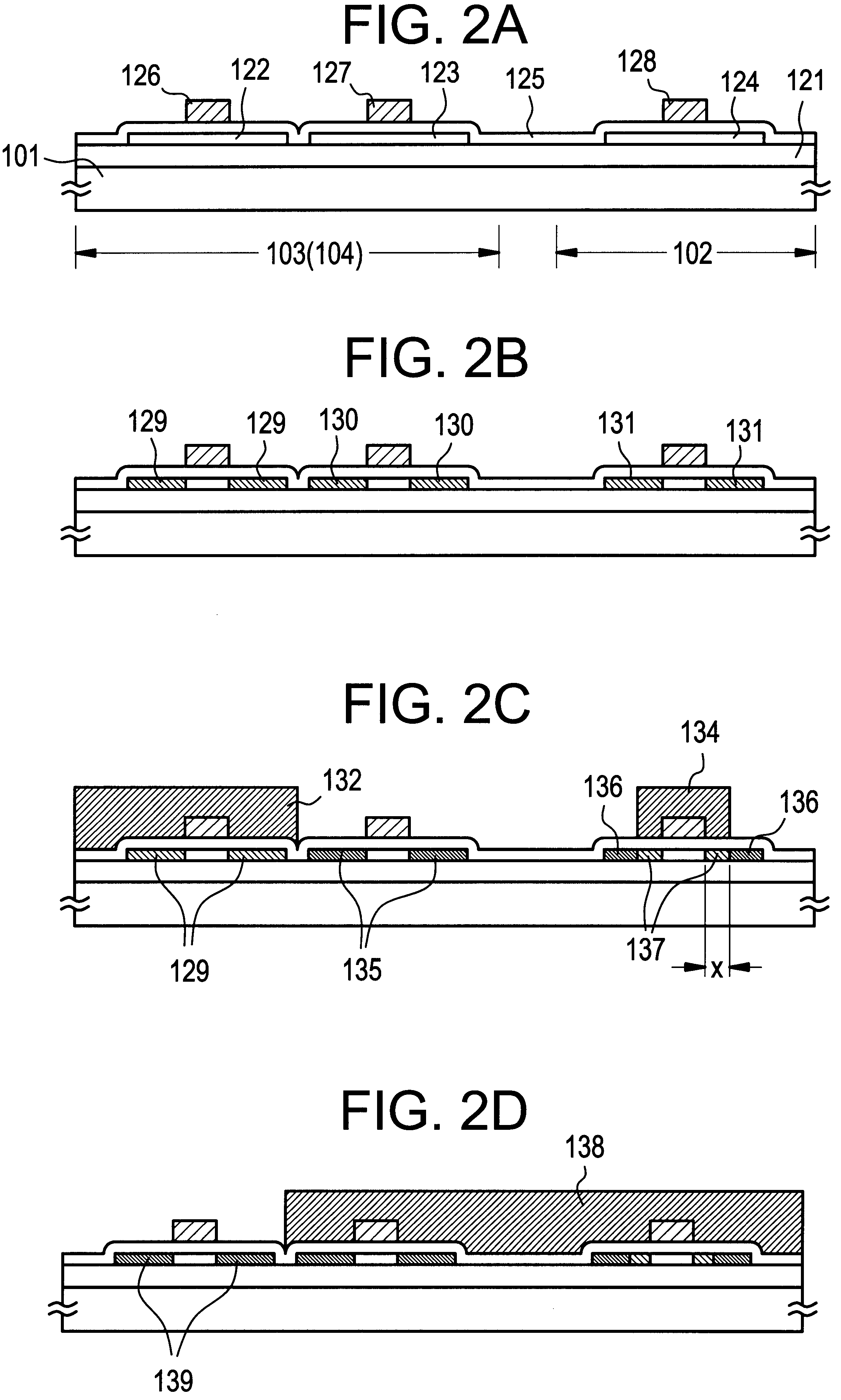Method of manufacturing an electro-optical device
- Summary
- Abstract
- Description
- Claims
- Application Information
AI Technical Summary
Benefits of technology
Problems solved by technology
Method used
Image
Examples
embodiment 1
This embodiment will be described with reference to FIGS. 1A-1B to 6. This embodiment is directed to a case where the invention is applied to an active matrix liquid crystal display device. FIG. 1A is a top view of a TFT substrate and FIG. 1B is a top view of an opposed substrate.
As shown in FIG. 1A, a TFT substrate 100 consists of a substrate 101 and a pixel area 102 and driver circuit areas 103 and 104 that are formed on the substrate 101. Pixel electrodes, TFTs that are connected to the respective pixel electrodes, and other members are arranged in the pixel area 102. Driver circuits for driving the TFTs in the pixel area 102 are arranged in the driver circuit areas 103 and 104.
As shown in FIG. 1B, an opposed substrate 200 consists of a substrate 201, an area 202 to confront the pixel area 102 of the TFT substrate 100, and areas 203 and 204 to confront the respective driver circuit areas 103 and 104. The TFT substrate 100 and the opposed substrate 200 are bonded together with a s...
embodiment 2
In this embodiment, the steps until pixel TFTs and driver circuit TFTs are formed to constitute a TFT substrate are the same as in the first embodiment and hence are not described here.
After the pixel TFTs and the driver circuit TFTs are formed in an integral manner to constitute the TFT substrate, gap retaining members are formed on the TFT substrate as shown in FIG. 3B. A process of forming gap retaining members according to this embodiment will be described below with reference to FIGS. 7A-7D and 8A-8C. The configuration of FIG. 7A is the same as that of FIG. 4A.
First, as shown in FIG. 7B, a 2.2-.mu.m-thick photosensitive polyimide film 311 is formed by spin coating. Thereafter, the substrate is left at the room temperature for 30 minutes to uniformize the thickness of the photosensitive polyimide film 311 over the entire TFT substrate 100 (leveling). Then, the TFT substrate 100 on which the photosensitive polyimide film 311 is formed is pre-baked at 120.degree. C. for 3 minutes....
embodiment 3
This embodiment is different from the first embodiment only in the number and arrangement of gap retaining members. Since this embodiment is the same as the first or second embodiment in the other points, a manufacturing process will not be described. In FIG. 10, the same reference numerals as in FIGS. 1A and 1B and FIG. 9 denote the same members as in the latter figures. In this embodiment, a sealing agent 403 is formed on the TFT substrate 100 side.
In this embodiment, as shown in FIG. 10, gap retaining members 401 are formed on the TFT substrate 100 so as to surround the pixel area 102 and gap retaining members 402 are formed on the TFT substrate 100 so as to surround the driver circuit areas 103 and 104. The gap retaining members 401 and 402 are shaped like a cylinder of 30 .mu.m in diameter and 2.2 .mu.m in height.
Then, rubbing is performed on the surface of the opposed substrate 200, i.e., the surface of an alignment film, and a sealing agent 403 is applied to the TFT substrate...
PUM
 Login to View More
Login to View More Abstract
Description
Claims
Application Information
 Login to View More
Login to View More - R&D
- Intellectual Property
- Life Sciences
- Materials
- Tech Scout
- Unparalleled Data Quality
- Higher Quality Content
- 60% Fewer Hallucinations
Browse by: Latest US Patents, China's latest patents, Technical Efficacy Thesaurus, Application Domain, Technology Topic, Popular Technical Reports.
© 2025 PatSnap. All rights reserved.Legal|Privacy policy|Modern Slavery Act Transparency Statement|Sitemap|About US| Contact US: help@patsnap.com



